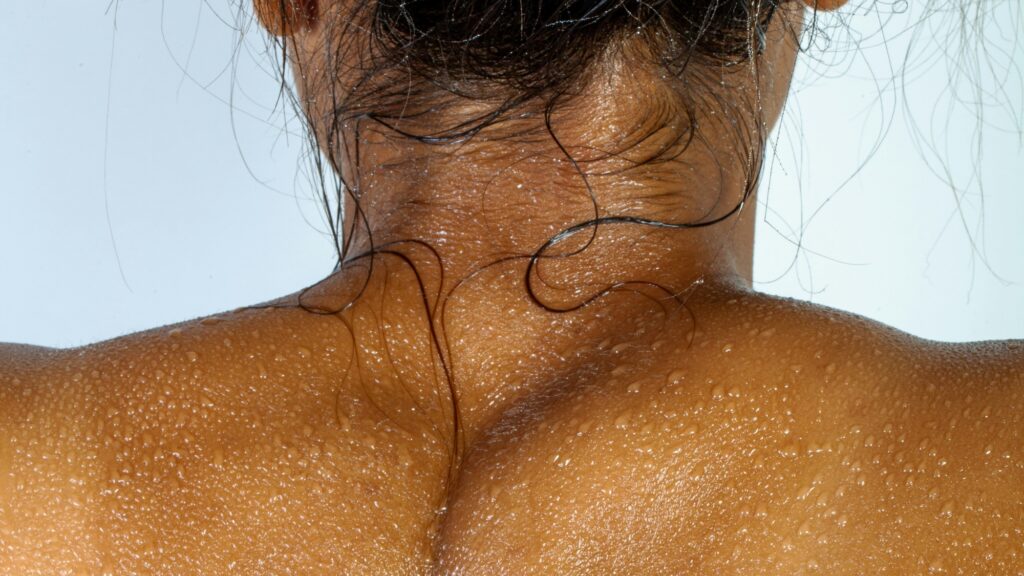Skin temperature is a key biomarker and indicator of well-being. Human beings require their core body temperature to be regulated within a small range to maintain health and peak performance.
But skin temperature fluctuates constantly. What is normal changes based on sleep, circadian rhythm, stimulants such as alcohol, hormonal changes, and overall physiological health.
Wearables such as the Ultrahuman Ring AIR continuously track skin temperature and establish individual baselines to help users understand how their body responds to different stressors, including illness, exercise, and the menstrual cycle.
In this article, we’ll explore skin temperature, how it fluctuates, and how to understand what your body is telling you.
Read more: How the Ultrahuman Ring AIR tracks skin temperature
Highlights
- Skin temperature is a key health biomarker, and it fluctuates based on sleep, stress, metabolism, and hormonal balance.
- Continuous skin temperature tracking demystifies this key biomarker and offers a window into our recovery, illness, and performance.
- The normal range for skin temperature varies depending on the individual, menstrual cycle, sleep vs wake, environment, and location on the body.
- Skin temperature elevates during sleep, but cools in the early morning as your core temperature warms and you prepare to wake.
Skin temperature: What’s normal?

Skin is the body’s largest organ and plays a crucial role in thermoregulation, maintaining core temperature despite environmental changes. Managed by the hypothalamus, this process involves signaling the skin, sweat glands, and muscles to regulate body heat.
While core temperature (the body’s internal temperature) remains stable between 36.1–37.2°C (97–99°F), average skin temperature fluctuates throughout the day. The trunk (chest and abdomen) is typically warmer, ranging from 33.5–36.9°C (92.3–98.4°F), while extremities like fingers, toes, and ears tend to be cooler due to faster heat loss. These variations depend on air temperature, blood circulation, physical activity, and hormonal changes.
To maintain balance, the body automatically regulates temperature in two ways:
Cooling down: When the body overheats, due to exercise, stress, or a warm environment, blood vessels dilate, bringing more blood to the skin’s surface to release heat. Sweating also helps by evaporating and cooling the body.
Staying warm: In cold conditions, blood vessels constrict, reducing blood flow to the skin to trap heat. Tiny muscles contract, causing goosebumps, which helps retain warmth.
Beyond these immediate responses, skin temperature during sleep follows a natural rhythm. It rises in the evening to help lower core temperature and promote restful sleep, then drops in the morning to encourage wakefulness.
Similarly, skin temperature and the menstrual cycle are also closely linked. Progesterone causes a slight rise after ovulation, with nighttime skin temperatures increasing during the luteal phase, and levels dropping before menstruation.
By continuously tracking skin temperature, we gain insights into how the body responds to sleep, hormonal shifts, and stress, helping optimise recovery, workouts, and wellbeing beyond just detecting fever or cold exposure.
Menstrual cycle and skin temperature

Core and skin temperature fluctuate throughout the menstrual cycle due to hormonal shifts, primarily from oestrogen and progesterone. These hormones regulate heat retention and release, shaping thermoregulation patterns.
In the follicular phase (before ovulation), high oestrogen levels promote heat loss by widening blood vessels, keeping core temperature lower. While skin temperature remains stable, it may feel cooler due to increased blood flow to the extremities.
At ovulation, a surge in progesterone triggers a 0.3°C to 0.7°C rise in core temperature as the body conserves heat. Skin temperature may briefly drop as blood flow shifts inward.
During the luteal phase, when progesterone dominates, core temperature remains elevated. Skin temperature fluctuates – sometimes warmer due to increased metabolism, but also prone to heat build-up as sweating becomes less efficient. Many experience warmth and difficulty sleeping during this phase.
Before menstruation, both core and skin temperature drop as progesterone declines, resetting the cycle. During menstruation, core temperature is at its lowest, and skin may feel cooler due to reduced metabolic activity and circulation changes.
Read next: The four stages of the menstrual cycle and how you might feel
Skin temperature during sleep

Before sleep, the core body temperature drops slightly, signalling the body to wind down. This cooling process, which begins late in the afternoon, promotes drowsiness and helps maintain restful sleep. At the same time, skin temperature rises to release heat, aiding relaxation. Disrupting this pattern – through bright lights, late-night activity, or stress – can make falling asleep more difficult.
As morning nears, the cycle reverses: core temperature rises while skin temperature drops, signalling wakefulness. This warming effect mirrors the energy boost after exercise, where a slight temperature increase enhances alertness.
These fluctuations are regulated by circadian rhythms – the body’s internal clock. Research by Rolf Fronczek in the Netherlands found that individuals with narcolepsy stayed awake more easily when their skin temperature was lowered, and their ability to fall asleep was influenced by warming or cooling their hands and feet.
Once asleep, the body becomes less responsive to external temperatures. During REM sleep, temperature regulation nearly shuts down – sweating and shivering are minimal, making individuals more sensitive to feeling too hot or cold.
Exercise recovery and skin temperature

Skin temperature plays a crucial role in thermoregulation during exercise. Studies indicate that aerobic fitness is positively correlated with increased skin temperature during exercise in male runners.
During high-intensity exercise, increased muscle activity generates heat, leading to greater blood flow to the skin to facilitate heat dissipation. In contrast, during low-intensity exercise, there is less demand for heat dissipation, reducing blood flow to the skin and causing a drop in skin temperature.
Fitness level and age also impact cutaneous vasodilation – the process of transferring heat from the body’s core to the skin. Lower aerobic fitness is linked to a reduced ability to dissipate heat. Research suggests that maintaining moderate-to-high fitness enhances thermoregulation, particularly around the torso.
Sickness

Body temperature regulation plays a critical role in detecting illness, with skin temperature offering an early indicator of fever. Research shows that skin surface temperature rises before core body temperature reaches fever levels – sometimes by up to three hours.
Fever (≥38°C) is a key sign of infection or inflammation, often accompanied by fluctuations in skin temperature. A study in an intensive care unit found that higher skin temperature was significantly associated with impending fever events.
Beyond fever, skin temperature can reflect other immune-related changes. Inflammatory responses – such as those in infections or autoimmune conditions – may cause localised warmth or overall temperature shifts. Continuous monitoring helps detect these changes early.
Conclusion
Skin temperature is highly individual and changes based on your environment, sleep, circadian rhythm, stage of menstrual cycle, and even factors such as alcohol. Having an insight into your personal skin temperature baselines can offer a window into your recovery from intense workouts, wellness and cycle.
References:
- Using wearable skin temperature data to advance tracking and characterization of the menstrual cycle in a real-world setting
- Changes In Narcoleptics’ Skin, Core Body Temperatures Affect Their Vigilance And Sleepiness | ScienceDaily.
- Exercise under heat stress: thermoregulation, hydration, performance implications, and mitigation strategies | Physiological Reviews
- Hydration effects on temperature regulation – PubMed







